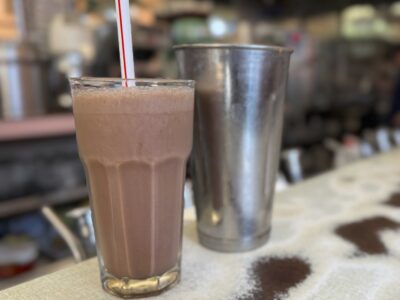Milkshakes, malts, concretes, frappes and more: A (delicious) guide to frozen drinks
By Canadian Press on August 14, 2025.

In the summer heat, we find ourselves drawn to that glorious section of the drinks menu that promises relief in the form of a cold, creamy, brain-freezing indulgence. But ordering a frozen drink looks different in different parts of the U.S., and in different restaurants and ice cream shops.
So, what is the difference between a milkshake, a malt, a frappe or maybe even a concrete?
Geography, tradition and local lingo all play a role in how frozen drinks are made and what they’re called.
Let’s break it down one strawful (or spoonful) at a time.
Milkshakes
Perhaps the most iconic of the bunch, the milkshake is typically a blend of ice cream and milk, blended until smooth and sippable. It’s simple and sweet. The ice cream usually forms the base flavor of the drink, and then other flavorings are involved, from syrups to extracts to fresh fruit.
At the Lexington Candy Shop, a 100-year-old luncheonette with an old-fashioned soda fountain on Manhattan’s Upper East Side, vanilla is the most popular milkshake — about 60% of all shakes ordered. That’s according to John Philis, who co-owns the shop with Bob Karcher, and whose grandfather, Soterios Philis, opened it in 1925.
Their next most popular flavors are chocolate, coffee and strawberry, Philis said. Lexington Candy uses homemade syrups, he says, which give the shakes “a nice wow.”
Other fan favorites at the shop include the classic black and white (vanilla ice cream and chocolate syrups) and the Broadway (chocolate syrup with coffee ice cream). In the summer, there are peach shakes.
Malts
A malt is essentially a milkshake with a scoop of malted milk powder thrown in. Malted milk powder is an old-fashioned flavoring that combines malted barley, wheat flour (caution to the gluten-free crowd) and evaporated milk. It gives the drink that distinct toasted, almost nutty flavor that transports you mentally to a 1950s diner or drive-in.
Fun fact: Malted milk powder was originally created as a nutrition booster, mostly for babies, but it found its home behind the counter of ice cream shops and luncheonettes. It adds slightly richer, old-school vibes to shakes and other frozen drinks.
There are also plenty of frozen blended drinks made with frozen yogurt instead of ice cream; these are sometimes known as fro-yo shakes.
Frappes
“Frappe” might mean different things to different people, depending on where they’re from. In New England, particularly Massachusetts, a frappe is what most of us would call a milkshake, made with milk, ice cream and usually some other flavorings.
In Massachusetts, you will hear this drink called “frap” (rhymes with “nap”), but believe me when I say there is no consensus on the correct pronunciation of the word. Sometimes a frappe from this region might simply be flavored cold milk, no ice cream involved.
There is also a genre of frappes associated with coffee-blended drinks, popularized by chains like Starbucks. Think icy, blended lattes, often topped with whipped cream. These are pronounced “frap-pays.”
Frosteds
Philis says that in New York City and other regions, a shake used to be known as a “frosted.”
“When someone comes in and orders a ‘frosted,’ I like this person,” Philis declares.
When McDonald’s and other fast-food chains started calling shakes “shakes,” the world followed suit, and the word “frosted” went out of fashion.
A frosted float, Philis explains, is a milkshake with an extra scoop of ice cream floating on top. Talk about gilding the lily!
Concretes
Then we have the concrete, an ultra-thick, creamy frozen dessert so dense that a spoon can stand upright in it. This is essentially frozen custard blended with mix-ins like candy, cookies or fruit, but no milk is added. It’s more of a scoopable treat than a slurpable one.
Concretes are popular where frozen custard is popular — mostly in the Midwest. Frozen custard has significantly less air in it than most ice cream, and a required 1.4% of egg yolks, which gives it its signature richness.
The concrete was invented at a frozen custard shop called Ted Drewes in St. Louis. If you buy one there, the server will hand it to you upside down, saying, “Here’s your concrete,” and it won’t fall out.
Travis Dillon (whose wife, Christy, is founder Ted Drewes’ granddaughter) gave this origin story: In the 1950s, a kid named Steve Gamir used to come in and ask the guy behind the counter for “the thickest shake you can make.” Employees started leaving the milk out of Gamir’s shakes, just running the custard through the machine, resulting in a shake that requires a spoon, not a straw.
Dillon says chocolate is their most popular flavor, then chocolate chip, strawberry and Heath Bar, but adds that there are lots of other flavors to explore, including a malted chocolate concrete — the best of two frozen-drink worlds!
Floats
Ice cream floats are the fizzy cousins of shakes. A scoop of ice cream (usually vanilla) is plopped into a glass of soda (usually root beer or cola, occasionally orange soda or a lemon-lime like Sprite) to create a frothy, sweet, bubbly concoction. Floats can be nostalgic for some folks.
Lexington Candy remains old-fashioned with their floats, making the sodas to order with syrup, stirring by hand, then adding the ice cream. In some areas of the country, you might hear a root-beer float referred to as a “brown cow.”
Ice cream sodas
Like floats, ice cream sodas are are not made in a blender. Philis says his are made with the syrup of your choice, coffee, half-and-half, plus seltzer. Then add a scoop of ice cream. He says usually the syrup and the ice cream are the same flavor, but people also like to mix and match.
Smoothies
Finally a word about smoothies, the supposedly more health-conscious frozen treat. Smoothies are traditionally made with fruit, yogurt, juice and sometimes ice. Sometimes, the fruit is frozen before it is blended into the drink. Smoothies are designed to feel virtuous, but they can still pack plenty of sugar, calories and richness, depending on the ingredients. For instance, if you see a peanut butter-chocolate-banana smoothie, you may realize quickly that this is more about flavor than health.
So the only question is: Is there enough time left in the summer to try the whole lexicon of frozen creamy drinks? Believe in yourself. I believe in you.
___
Katie Workman writes regularly about food for The Associated Press. She has written two cookbooks focused on family-friendly cooking, “Dinner Solved!” and “The Mom 100 Cookbook.” She blogs at https://themom100.com/. She can be reached at Katie@themom100.com.
___
For more AP food stories, go to https://apnews.com/hub/recipes
Katie Workman, The Associated Press
-50




